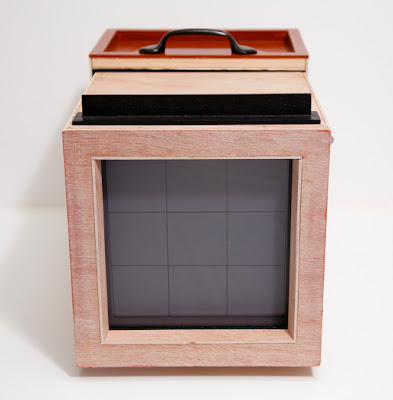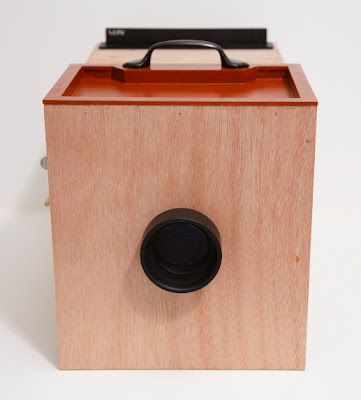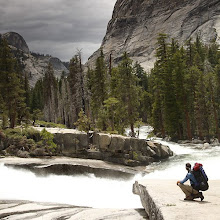Mountain Over Water. What is that you ask, well read on dear friends!
I'm back, just not here! I have built a new blog and it's pretty cool. This blog will stay up for a little while longer to redirect readers to my new blog Mountainoverwater.com. I have also rebuilt, redesigned and re-populated my portfolio website Scottmansfield.com. You'll see several fresh changes, new work and old favorites. It feels great to have a reboot, a change a new direction a place that feels more like me. Take a long peek around and drop me a line I'd love to hear your ideas and feelings!
Thank you all and I look forward to seeing at mountainoverwater.com
3.13.2011
11.07.2010
Camera Project - Part 3
DONE! Isn't she pretty, well boxy if nothing else.
 |
| 6x6 inch negative, nice an big! |
although I don't imagine I'll be using the f/32-f/64 range all that much. The sensitivity of the dry waxed negatives isn't that great. In full BDE sun the exposure will be something like 4-5minutes at f/16, and that gets dramatically longer the more stopped down it gets. But that's the backbone of the whole project, to slow down.
 The construction took a bit longer that expected, about two weeks longer(a good portion of that was building the box and adding some final touches to the camera to make it look more pleasing, hey this is a visual art-form after all, ones tools must be nice to look at!)
The construction took a bit longer that expected, about two weeks longer(a good portion of that was building the box and adding some final touches to the camera to make it look more pleasing, hey this is a visual art-form after all, ones tools must be nice to look at!)I have to admit I'm ready to move on to the next stage, photographing with it. I have a feeling this is where the troubleshooting, tweaking, fidgeting and fun will really begin. Since the final prints will be contact printed by the sun and not enlarged I don't need to setup a dedicated darkroom (couldn't even if I wanted to, ha!). I do however need a darkened room with a decent table to lay out several chemical trays for the intricate steps from sensitizing the negatives to developing the final prints. Our bathroom is small, but it'll do just fine, I even worked it out so the toilet can still be used during the 12-14 hour procedures (aren't a nice husband, wink!).
 |
| shopping list #1 |
 |
| The film holder with dark-slide removed. I had to sand away the black paint on the edges to make it fit. |
The film holder was the hardest part to construct. I had to alter the design from the book to make it work for my camera, and in doing so I added a few alterations I think make it a better design. I added a film slot to load the film and mirrored the back so I have two exposures per holder. I only built one for the moment because I wanted to test it out before I 'mass' produced more of them.

This tube piece was photographed for the previous post, but I wanted to show it up close. It attaches to the lens and the slot on the top is for the aperture cards to slide into. See the previous camera project post to see it on the camera. The round piece in front is the 'lens cap' and fits snuggly in the front hole. I'll take it off and on to start and stop the exposure. With exposure times of upwards of 5-20 minutes the camera doesn't need a mechanical shutter. And lastly, a picture of the ground glass holder. This slides into the film holder slot at the rear of the camera. The image needs a frosted surface to focus onto. After composing and focusing I remove this ground glass holder and replace it with the film holder and the image is ready to be exposed.
I've been using a few books as guidelines and must give credit to both of them. Alan Greene's Primitive Photography and Christopher James's The Book of Alternative Photographic Processes. Both have been an inspiration and a foundation for the initial steps of this project. I'll continue to reference them as I move away from the workshop and into the darkroom.
The next post will be about the darkroom setup and the initial stages of negative construction. This camera as been an amazing build. It's made me appreciate photography in a new way and I'm giddy to start shooting with it.
Stay Tuned!
 |
| all wrapped up! |
10.12.2010
A Little Sierra Beauty
A little high sierra beauty to brighten your mid-week. Photographed this past July from a most amazing 50 mile solo trek through some of my favorite country. The story behind and more images from shall be forth coming. But for now smell the clean alpine air, hear a distant breeze build and watch the immaculate apenglow ignite the eastern sky.
(click on images to view larger)
10.09.2010
Existentialism and a Pretty Flower
A little existentialism if you please. Is art about execution or idea? As a practitioner of a heavily technical medium I'm inclined towards former, but as an artist I'm inclined toward the latter. For visual artists it's an important question to consider. I feel non-visual mediums don't suffer as much from this, a poorly written and preformed piece of music is instantly recognizable, as is bad writing as well as poor acting. Yet in the visual media one is almost always forced to describe in words what the point is, why this particular stroke of color or that symbolic metaphor. The first minute of Bach's Suite for Cello leaves me breathless, and yet I've never read his personal interpretation of it. Is it the responsibility of the artist to do so, or not. Shouldn't the idea behind the work be clear if the execution was well executed. Or does it help the viewer understand a deeper, more personal meaning if the artist expands on the idea verbally. Visiting modern art shows, in all mediums, I sometimes get the feeling well crafted pieces are brushed aside as merely that. That somehow, complete control of the tools will invariably inhibit the free expressive use of them. This bothers me because unsubstantiated ideas are cheap and prolific. It takes beautiful execution in your chosen medium to portray that idea with grace. I'm a proponent of understanding every nuance of the tools you use to create your work. Chance favoring the prepared mind. I recently carved a didgerdoo while on vacation and when deciding on it's surface finish I came across an article talking about how the native Aboriginals of Australia have no distinction between art and craft, they are one in the same. Perhaps only when execution and idea meld together does true art become made. No words, no descriptions, no eloquent debates, just the inevitable magnifying glass that true art holds against the self, the species and the world.
So with that, here's a non-existential pretty flower to brighten your Sunday!
Cheers all!
10.08.2010
Camera Project - Part 2
I've now been working on this project for two weeks, and it's really taking shape. The camera is essentially two boxes, nested together (see previous post for fun historical info). Both sides are complete (minus the finish coat, not sure what that's going to be). I designed and constructed the first film holder, which holds a single negative on each side, and put together the ground glass insert which fits into the same slot the film holder goes into and which the image is focused upon. The holders have been by far the most complex items to design and build. Each consisting of several layers of very thin wood slowly glued together to form a rail system where film is inserted behind a removable darkslide (which stays in place until the moment of exposure). I've also finished building the aperture system. Because it's a single element lens the apertures have to go in front of the lens roughly 1/7 the focal length. I designed a card system where each card has a different hole aperture drilled/cut into it. I merely slip the aperture I want into a slot I cut into an extension tube that fits snuggly over the lens (you'll see in the pictures below). It's been designing, constructing, designing, constructing, repeat for awhile now. I think most of that is finished and now it's time to move into the darkroom projects (or my small bathroom which will have some unique alterations). Since I'm doing the entire process, from camera/lens construction to film/printing paper manufacturing I had to hunt down a chemical supply house and labware supply house.
Not being a chemist it's been an interesting two days making a grocery list of chemicals I need, from silver nitrate to potassium dichromate. There's about 15 different chemicals I need, some are benign like milk lactose, while others are a bit nasty. Not ever having a formal chemistry class it's been more than helpful having a very smart wife who can not only tell me how many oxygen atoms happen to be in sodium sulfite but can write out the chemical structure and tell me what happens when it's mixed with anything else on my list. She is one smart cookie! The funny part is I have to fill out a DEA form in order to get some of these, not sure what potassium iodide is used for other than to coat photographic paper with?
Initially I wanted to do this as a fun camera project, to build something that has real historical significance to my chosen career, a reaction to the ever increasing speed of digital media. I wanted to see if I could hand produce every aspect of the photographic process, from camera and lens to the negative and final print. Totally analog. To slow down each process to it's foundation of conception. When the negs take 4 hours to produce and dry, have to be shot within a few days, and where developing alone takes 2-3 hours (it's not a printing-out process, but is developed in a solution of Gallic Acid) I thought it would force me to see photography and the way I look through the lens in a new way. It has. Photography as an artistic medium is older that modern painting, yet the technology that produces it continually evolves whereas a painter today is essentially using 500 year old techniques. I noticed something interesting the other day, something we all do now, we look at the back of the camera after every shot. We now expect instant results and I truly think this dulls the external creative eye. How many times have you really taken the time to look, to watch and absorb the scene before you. Slow down sometimes, it opens new creative pathways. Stay tuned, more to come...
Not being a chemist it's been an interesting two days making a grocery list of chemicals I need, from silver nitrate to potassium dichromate. There's about 15 different chemicals I need, some are benign like milk lactose, while others are a bit nasty. Not ever having a formal chemistry class it's been more than helpful having a very smart wife who can not only tell me how many oxygen atoms happen to be in sodium sulfite but can write out the chemical structure and tell me what happens when it's mixed with anything else on my list. She is one smart cookie! The funny part is I have to fill out a DEA form in order to get some of these, not sure what potassium iodide is used for other than to coat photographic paper with?
Initially I wanted to do this as a fun camera project, to build something that has real historical significance to my chosen career, a reaction to the ever increasing speed of digital media. I wanted to see if I could hand produce every aspect of the photographic process, from camera and lens to the negative and final print. Totally analog. To slow down each process to it's foundation of conception. When the negs take 4 hours to produce and dry, have to be shot within a few days, and where developing alone takes 2-3 hours (it's not a printing-out process, but is developed in a solution of Gallic Acid) I thought it would force me to see photography and the way I look through the lens in a new way. It has. Photography as an artistic medium is older that modern painting, yet the technology that produces it continually evolves whereas a painter today is essentially using 500 year old techniques. I noticed something interesting the other day, something we all do now, we look at the back of the camera after every shot. We now expect instant results and I truly think this dulls the external creative eye. How many times have you really taken the time to look, to watch and absorb the scene before you. Slow down sometimes, it opens new creative pathways. Stay tuned, more to come...
Process picture time!
(not in construction order, sorry)
 |
| Laying out wood and designs for the film holder |
 |
| More film holder work |
 |
| Attaching the lens board to the front box |
 |
| Prepping the front box for black paint on the inside, the rear box is standing on end, you can see the film slot. |
 |
| All the layers of the film holder |
 |
| It took three days to fully complete the film holder, I hope the others don't take as long, sheesh! |
 |
| The lens element fit well, but I had to fill in some light gaps on the edges. |
 |
| Finished and painted film holder without the darkslide in place. |
 |
| The ground glass holder, the blue piece to the left is a piece of plexiglass with it's protective layer on. |
 |
| Completed ground glass with a piece of frosted acetate glued on so the image has something to focus onto, |
 |
| A side view of the camera's focus locking mechanism. I needed a way to lock both boxes after focusing was complete, |
 |
| A closer look at the mechanism |
 |
| The aperture tube and wood to make the aperture card slot that'll hold the aperture hole cards. |
 |
| Figuring out the correct size for each aperture stop, all products of the square root of 2, kind of neat how it works out. |
 |
| An aperture card with a f/64 hole cut into it. |
 |
| Finished and tested in place. I'll make about 5 aperture cards from f/16 to f/64 |
 |
| The installed aperture holder with aperture card. |
 |
| Initial construction of the front box. |
 |
| Side view of the camera before I installed the lens board and lens (bottom left) |
 |
| Initial stages of the film holder |
 |
| The front box painted on the inside. The black really soaks up light, no need for felt liner. |
 |
| Getting ready to mount the lens element into its plumbing fixture holder |
 |
| The mounted lens in place. |
 |
| About halfway through film holder construction |
 |
| The rear box and film slot being constructed |
 |
| Test fit with everything |
 |
| Both boxes in the initial stages |
 |
| Laying out the lens board for marking and cutting, you can see the rear box nesting inside. |
 | ||||||
| Starting on the first film holder, laying out and cutting the wood |
Now go build something, it's fun!
Subscribe to:
Comments (Atom)
















